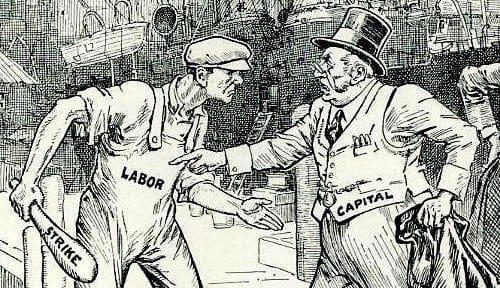Story by Robert Reich •AlterNet

substackcdn.com
The largest and oldest class struggle in America has been between capital and labor — between the owners of big corporations and the people who work for them, between those who live off their investments and those who live off their wages.Today, this struggle takes the form of giant corporations that have monopolized their markets and workers who are trying to organize labor unions.
This is why you’re hearing so much about the Federal Trade Commission and the Antitrust Division of the Justice Department going after Amazon and Google, respectively.
(They’re also going after Ticketmaster and Live Nation, Kroger and Albertsons, and a wide range of other giant corporations and proposed mergers.)
And why you’re also hearing so much about strikes — the UAW, writers and actors, nurses, workers at Kaiser Permanente, Starbucks baristas, and others. And about attempts to organize Amazon and other anti-union companies.
In this struggle, corporate monopolies and labor organizations both seek more economic power.
How? The side that can reduce choices available to the other side — through monopolization of the market, or through labor organizing — gains power.
Since the 1970s, corporate monopolizing has increased while labor organizing has been on the wane.
Antitrust law had become a dead letter. Even Democratic Presidents Jimmy Carter, Bill Clinton, and Barack Obama abandoned it.
Meanwhile, corporations routinely bashed unions and fired workers who attempted to form them (often treating back pay they had to give fired workers as costs of doing business).
And corporations moved to so-called “right-to-work” states that enacted laws making it particularly difficult to form unions.
Carter, Clinton, and Obama all promised “labor law reform” that would strengthen unions. None ever followed through.
But under Joe Biden, there’s been a monumental shift. Antitrust enforcement has surged. Efforts to form unions have been protected and encouraged.
This shift has gotten lost under the mainstream media’s fixation with government spending, taxing, and the federal debt.
This is too bad, because the shift has been one of Biden’s most important achievements. If it continues under a second Biden term, it could change the structure of the U.S. economy — to bring capital and labor into better balance. Biden appointed Lina Khan chair of the FTC and gave her a majority of commissioners who are serious about rooting out monopolies. Biden also appointed trust-buster Jonathan Kanter to run the Antitrust Division of the Justice Department.
Khan and Kanter are the most aggressive anti-monopolists in half a century.
Meanwhile, Biden appointed Jennifer Abruzzo to be general counsel of the National Labor Relations Board and gave her a board that’s serious about giving workers the right to organize.
Under Abruzzo’s leadership, the NLRB is revolutionizing labor organizing — requiring companies that have committed unfair labor practices to bargain with their employees, accelerating the period between union petitions and elections, making it harder for companies to fire workers for organizing or to misclassify employees as independent contractors, and much else.
Part of the current rash of strikes reflects the increasing labor power being brought about by the NLRB.These three agencies — the FTC, the Antitrust Division of Justice, and the NLRB — are the new crucibles in the struggle between capital and labor. Step by step, they’re diminishing the power of giant corporations and increasing the power of workers.
But to make a palpable difference, they will have to keep at it for years — at the least, through a second Biden administration. If Khan, Kanter, and Abruzzo move to other jobs, their replacements will need to be no less aggressive.
The struggle is not easy. Big corporations and Wall Street are appealing many of their administrative actions and successful court decisions. And, needless to say, big corporations and Wall Street have armies of lawyers whose job it is to enlarge the power of capital and suppress the power of labor.
Yet I’m astounded at how much progress the three agencies, under these three leaders, have made in just over two and a half years. And how little the mainstream media have reported on the overall strategy — especially given how central it could become to the lives of average Americans.
No comments:
Post a Comment